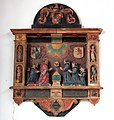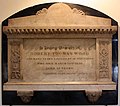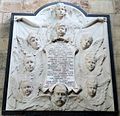English church monuments
This article needs additional citations for verification. (May 2009) |
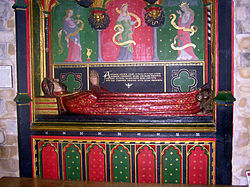
A church monument is an architectural or sculptural memorial to a deceased person or persons, located within a Christian church. It can take various forms ranging from a simple commemorative plaque or mural tablet affixed to a wall, to a large and elaborate structure, on the ground or as a mural monument, which may include an effigy of the deceased person and other figures of familial, heraldic or symbolic nature. It is usually placed immediately above or close to the actual burial vault or grave, although very occasionally the tomb is constructed within it. Sometimes the monument is a cenotaph, commemorating a person buried at another location.
Once only the subject of antiquarian curiosity, church monuments are today recognised as works of funerary art. They are also valued by historians as giving a highly detailed record of antique costume and armour, by genealogists as a permanent and contemporary record of familial relationships and dates, and by students of heraldry as providing reliable depictions for heraldic blazons. From the middle of the 15th century, many figurative monuments started to represent genuine portraiture where before had existed only generalised representations.
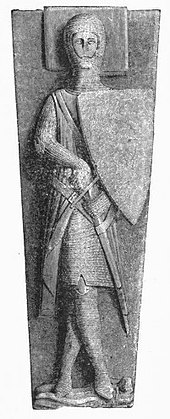
Development
[edit]Medieval period
[edit]The earliest English church monuments were simple stone coffin-shaped grave coverings incised with a cross or similar design; the hogback form is one of the earliest types. The first attempts at commemorative portraiture emerged in the 13th century, executed in low relief, horizontal but as in life. Gradually these became full high-relief effigies, usually recumbent as in death, and, by the 14th century, with hands together in prayer. In general, such monumental effigies were carved in stone, marble or wood, or cast in bronze or brass. Often the stone effigies were painted to resemble life, but on the vast majority of medieval monuments, the paint has long since disappeared. The cross-legged attitude of many armoured figures of the late 13th or early 14th centuries was long supposed to imply that the deceased had served in the Crusades, had taken crusading vows, or more specifically had been a Knight Templar; but these theories are now rejected by scholars.[1][2] Feet were often supported by stylised animals, usually either a lion indicating valour and nobility (generally for men), or a dog indicative of loyalty (generally for women).[3] Sometimes the footrest was an heraldic beast from the deceased's family coat of arms.
By the early 13th century, the effigies were raised on tomb-style chests (known as tomb chests, altar tombs or table tombs) decorated with foliage, heraldry or architectural detailing. Soon such chests stood alone with varying degrees of decorations. By the end of the century, these often had architectural canopies. Small figures of weepers (often friends or relatives identified by their coats of arms) were popular decorative features. In the 15th century, the figures were often portrayed as angels or saints, and the chest might include a cadaver. The most refined monuments were made of alabaster. Around the 13th century, smaller two-dimensional effigies incised in plates of brass and affixed to monumental slabs of stone became popular too. These memorial brasses were somewhat cheaper and particularly popular with the emerging middle class.
Early modern period
[edit]The removal of almost all the many wall-paintings in English churches in the iconoclasm of the English Reformation and the English Commonwealth left plenty of bare spaces. Over the following centuries, these were gradually filled by monuments of the wealthy. It is the lack of competition from religious paintings and a tolerance of figurative sculpture in memorials, which most Protestant countries did not share, that produced the exceptionally rich English holdings of large sculptural church monuments.
In the 16th century, church monuments became increasingly influenced by Renaissance forms and detailing (pilasters, wreaths, strapwork, skulls, coffered arches, obelisks, allegorical figures, etc.), particularly in France, the Netherlands and, eventually, England. There were major innovations in effigial posture, the deceased often being shown reclining or kneeling in prayer and surrounded by the whole family, as in life. Cadavers were replaced by skeletons. The 'hanging' mural or wall monument also became popular, sometimes with half-length 'demi-figures'; and also the floor-bound heraldic ledger stone. The 17th century saw an increase in classicism and the use of marble. Effigies might be sitting or standing, grief-stricken, shrouded or, unusually, rising from the grave. Busts and relief portraits were popular. High Baroque monuments were some of the grandest ever constructed. Decoration turned to cherubs, urns, drapery, garlands of fruit and flowers. In the 18th century, church monuments became more restrained, placed before two-dimensional pyramids, but more Roman-like, with the deceased often depicted in Roman dress or as a cameo-like 'medallion portrait'. The Rococo style gave more movement to these figures.
Victorian period
[edit]The early 19th century brought Greek Revival monuments, some quite plain wall plaques, some with sentimental and romantically realistic figures (perhaps rising to heaven), or other devices such as weeping willows. Gothic Revival followed, with the obvious return to alabaster, tomb chests and recumbent effigies. However, the Victorian age saw many differing styles, until large-scale monuments fell out of fashion at the end of the century. 20th-century large-scale monuments are not unknown, but quite rare.
Examples of English church monuments
[edit]The church monuments of England, in particular, have been preserved in far greater numbers and, generally, in better condition than those of other countries. They are second to none in artistic merit. Fine examples may be found in cathedrals and parish churches in every county.
-
Tomb depicting a cross-legged knight, thought to be Hamon Belers, in St Mary's Church, Melton Mowbray, Leicestershire (circa 1300).
-
The cadaver tomb of Bishop Richard Fleming in Lincoln Cathedral. He is depicted as if alive at the top; the lower effigy shows his decaying corpse in a shroud (1431).
-
Alabaster effigies of John Harington, 4th Baron Harington and his wife Elizabeth Courtenay, at the Church of St Dubricius, Porlock in Somerset (circa 1471).
-
Monument to John Manners, 4th Earl of Rutland in St Mary the Virgin's Church, Bottesford, Leicestershire, by Gerard Johnson the elder (1588).
-
Monument to Sir Edward Denny and his wife at Waltham Abbey Church (1600). The kneeling figures in the frieze below depict his ten children and are known as "weepers". In the spandrels, allegorical figures of Fame and Time look on.
-
The Layer Monument Marble polychrome mural monument at the Church of Saint John the Baptist, Maddermarket, Norwich circa 1600.
-
Monument to Richard Stone and his wife at St Mary's Church, Holme-next-the-Sea in Norfolk (1607).
-
Thelwall's mural monument in the chapel at Jesus College, Oxford (1630).
-
Effigial monument in Worcester Cathedral, circa 1640.
-
The monument to Sir John Hotham in St Mary's, South Dalton, East Yorkshire. The sculpture dates from after 1697. It includes a skeleton and figures representing the four cardinal virtues.
-
Part of the memorial placed by Ann Bellamy Lynn to her husband George at St Mary's Church, Southwick, Northamptonshire (1758).
-
Monument to Major-General Sir William Ponsonby in the crypt of St Paul's Cathedral, London (1815). The winged figure of Victory symbolises the general's death at the Battle of Waterloo.
-
A Victorian wall monument (1890) at St Paul's Church, Shadwell, London.
-
Monument to Emily, the wife of Admiral Charles Lister Oxley in Ripon Cathedral. The angelic heads depict the couple and their seven children (1898).
"An Arundel Tomb"
[edit]
"An Arundel Tomb", one of the best-known works by 20th-century English poet Philip Larkin, was inspired by a 14th-century English effigial monument. It was Larkin's response to a tomb monument in Chichester Cathedral, and the fact that the husband and wife subjects were portrayed holding hands. The photo at right also shows the stylized lion and dog figures at the feet of the lord and lady, respectively.
See also
[edit]Notes
[edit]- ^ Puckle, Bertram S. Funeral customs, Forgotten Books, 1926 ISBN 1-60506-807-1, ISBN 978-1-60506-807-7 p. 194 Archived 2023-12-11 at the Wayback Machine
- ^ Harris, O.D. (2010). "Antiquarian attitudes: crossed legs, crusaders and the evolution of an idea". Antiquaries Journal. 90: 401–40. doi:10.1017/s0003581510000053. S2CID 206212438. Archived from the original on 2016-03-05. Retrieved 2014-05-15.
- ^ Quinn, William A. Chaucer's dream visions and shorter poems, Routledge, 1999. ISBN 0-8153-3100-2, ISBN 978-0-8153-3100-1, p. 190 Archived 2023-12-11 at the Wayback Machine
- ^ Pevsner, Nikolaus (1952). "Tawstock". North Devon. The Buildings of England. Harmondsworth: Penguin Books. p. 153.
Bibliography
[edit]- Badham, Sally (2011). Medieval Church and Churchyard Monuments. Oxford: Shire. ISBN 9780747808107.
- Badham, Sally; Oosterwijk, Sophie, eds. (2010). Monumental Industry: the production of tomb Monuments in England and Wales in the long fourteenth century. Donington: Shaun Tyas. ISBN 9781907730009..
- Crossley, F.H. (1921). English Church Monuments, A.D. 1150–1550. London: B.T. Batsford.
- Esdaile, K.A. (1946). English Church Monuments, 1510–1840. London: B.T. Batsford.
- Kemp, Brian (1980). English Church Monuments. London: B.T. Batsford. ISBN 0713417358.
- Llewellyn, Nigel (2000). Funeral Monuments in Post-Reformation England. Cambridge: Cambridge University Press. ISBN 0-521-78257-0.
- Saul, Nigel (2009). English Church Monuments in the Middle Ages: history and representation. Oxford: Oxford University Press. ISBN 9780199215980.
- Sherlock, Peter (2008). Monuments and Memory in Early Modern England. Aldershot: Ashgate. ISBN 978-0-7546-6093-4.





![Monument to John Wrey (d.1597); originally in St Ive Church, Cornwall, but moved to St Peter's Church, Tawstock, Devon, in 1924.[4]](http://up.wiki.x.io/wikipedia/commons/thumb/1/18/WreyKilligrewMonument_TawstockChurch.JPG/79px-WreyKilligrewMonument_TawstockChurch.JPG)

